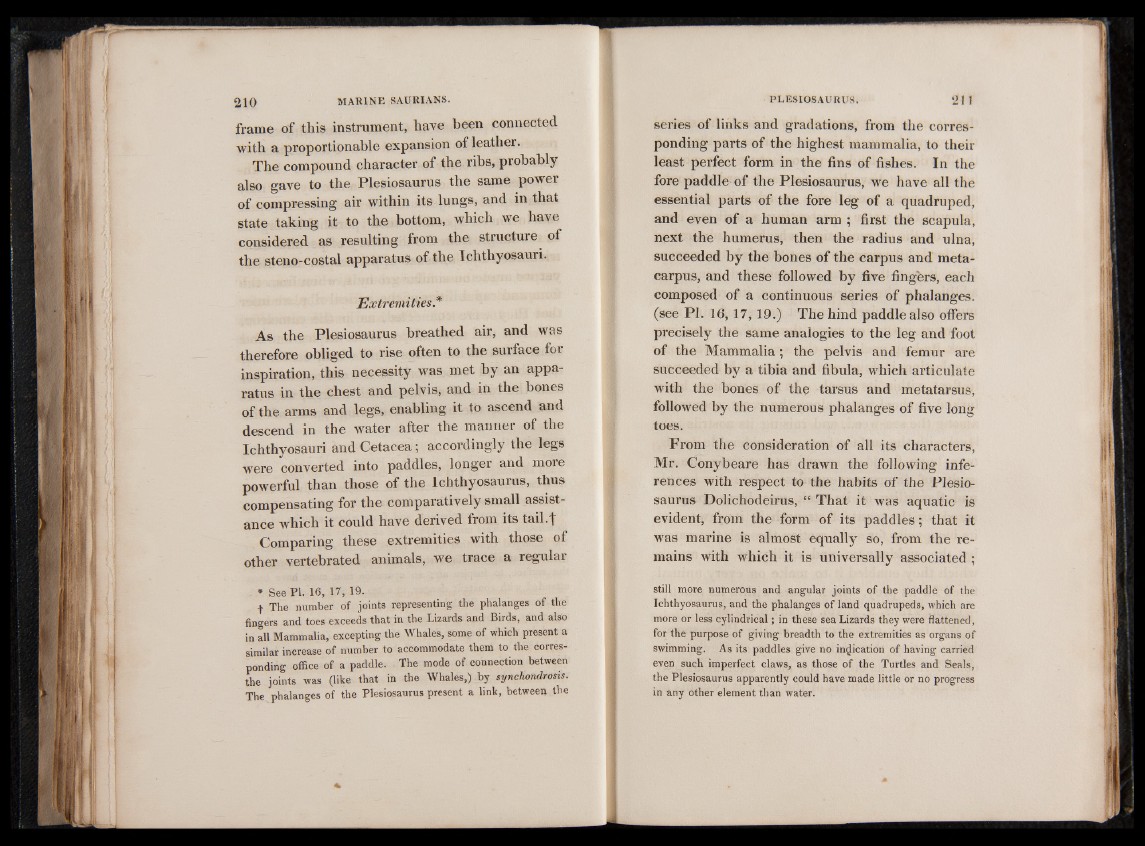
frame of this instrument, have been connected
with a proportionable expansion of leather.
The compound character of the ribs, probably
also gave to the Plesiosaurus the same power
of compressing air within its lungs, and in that
state taking it to the bottom, which we have
considered as resulting from the structure of
the steno-costal apparatus of the Ichthyosauri.
Extremities*
As the Plesiosaurus breathed air, and was
therefore obliged to rise often to the surface for
inspiration, this necessity was met by an apparatus
in the chest and pelvis, and in the bones
of the arms and legs, enabling it to ascend and
descend in the water after the manner of the
Ichthyosauri and Cetacea; accordingly the legs
were converted into paddles, longer and more
powerful than those of the Ichthyosaurus, thus
compensating for the comparatively small assistance
which it could have derived from its tail ."f
Comparing these extremities with those of
other vertebrated animals, we trace a regular
* See PI. 16, 17, 19.
The number of joints representing the phalanges of the
fingers and toes exceeds that in the Lizards and Birds, and also
in all Mammalia, excepting the Whales, some of which present a
similar increase of number to accommodate them to the corresponding
office of a paddle. The mode of connection between
the joints was (like that in the Whales,) by synchondrosis.
The phalanges of the Plesiosaurus present a link, between the
series of links and gradations, from the corresponding
parts of the highest mammalia, to their
least perfect form in the fins of fishes. In the
fore paddle of the Plesiosaurus, we have all the
essential parts of the fore leg of a quadruped,
and even of a human arm ; first the scapula,
next the humerus, then the radius and ulna,
succeeded by the bones of the carpus and metacarpus,
and these followed by five fingers, each
composed of a continuous series of phalanges,
(see PI. 16, 17, 19.) The hind paddle also offers
precisely the same analogies to the leg and foot
of the Mammalia; the pelvis and femur are
succeeded by a tibia and fibula, which articulate
with the bones of the tarsus and metatarsus,
followed by the numerous phalanges of five long
toes.
From the consideration of all its characters,
Mr. Conybeare has drawn the following inferences
with respect to the habits of the Plesiosaurus
Dolichodeirus, “ That it was aquatic is
evident, from the form of its paddles; that it
was marine is almost equally so, from the remains
with which it is universally associated ;
still more numerous and angular joints of the paddle of the
Ichthyosaurus, and the phalanges of land quadrupeds, which are
more or less cylindrical; in these sea Lizards they were flattened,
for the purpose of giving breadth to the extremities as organs of
swimming. As its paddles give no indication of having carried
even such imperfect claws, as those of the Turtles and Seals,
the Plesiosaurus apparently could have made little or no progress
in any other element than water.